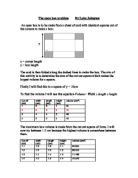Introduction
In this project, I am aiming to:
- Determine the size of square cut from any given square sheet of card which makes the volume of an open top box as large as possible.
- Determine the size of square cut from any given rectangular sheet of card which makes the volume of the resulting open top box as large as possible
4 squares were cut from the paper (1 from each corner). It was then folded along the lines (see diagram), to make an open top cuboid. Different size squares being cut from the paper each time resulted in a different volume. I spent time ring to calculate the size of the square using trial and improvement.
Firstly, I examined the size of cut that gave the largest volume of open box by using squared paper to test out some different sizes of squares and rectangles. I then used Microsoft Excel spreadsheets to calculate the lengths, depths and widths to give me the volume of the open box. I calculated the size of cut that would give me the greatest volume to 3 decimal places.
To create the box, the equal size squares are cut from the four corners of the card, and it is then folded along the dotted lines.
I then put the resultant data into tables to try and calculate relationships between things such as length and square cut. I then tried to calculate a formula that would give me the size of square that must be cut to give me the optimum volume of square or rectangle. I conducted this on my spreadsheet.
Trial and Improvement
The first square I did was a 10cm x 10cm square. I started off by choosing 4 whole numbers. I chose 0cm, 1cm, 2cm and 3cm. I used the following formula to calculate the length and width of the open box after the squares had been removed from the corners: 10-(1x2). This was for the square being removed size 1cm, and it was the same formula for length and width as it is a square. The depth is always the same as the size of square cut (x). I then multiplied the length, depth and width to give me the volume. With the 10 x 10 square, the largest volume so far was between 1.5cm and 2.5cm, so I then put in square cut sizes at an interval of 0.1 cm between 1.5 and 2.5. This then showed that the optimum volume was somewhere between 1.6cm and 1.7cm. I then progressed to 2 decimal places, and discovered that it was between 1.66cm and 1.67cm. For even more detail I continued to 3 decimal places. I found that the optimum cut for a 10cm x10cm square to be 1.666cm. I then multiplied the length by the width by the depth to get the volume. I then repeated this with square sizes 5cm x 5cm, 8cm x 8cm and 50cm x 50cm (to compare with a 5cm x 5cm square).
Investigation 1 – Sqaure
To find the length of the cut-out corners that gives the maximum volume for the open box formed for any sized piece of square card. I will calculate and show the optimum square cut to 3 decimal places. I will investigate square pieces of paper with dimensions 5cm x 5 cm, 8 cm x 8 cm, 10 cm x 10 cm and 50 cm x 50 cm.
Square Card Dimensions 5cm x 5cm
Volume in cm3, square cut in cm







